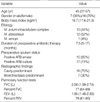1. Wallace RJ Jr, Cook JL, Glassroth J, Griffith DE, Olivier KN, Gordin F. Diagnosis and treatment of disease caused by nontuberculous mycobacteria. This official statement of the American Thoracic Society was approved by the Board of Directors, March 1997. Medical Section of the American Lung Association. Am J Respir Crit Care Med. 1997. 156:S1–S25.
2. Griffith DE, Aksamit T, Brown-Elliott BA, Catanzaro A, Daley C, Gordin F, Holland SM, Horsburgh R, Huitt G, Iademarco MF, Iseman M, Olivier K, Ruoss S, von Reyn CF, Wallace RJ Jr, Winthrop K. An official ATS/IDSA statement: diagnosis, treatment, and prevention of nontuberculous mycobacterial diseases. Am J Respir Crit Care Med. 2007. 175:367–416.

3. Field SK, Cowie RL. Lung disease due to the more common nontuberculous mycobacteria. Chest. 2006. 129:1653–1672.

4. Koh WJ, Kwon OJ, Lee KS. Diagnosis and treatment of nontuberculous mycobacterial pulmonary diseases: a Korean perspective. J Korean Med Sci. 2005. 20:913–925.

5. Yim JJ, Park YK, Lew WJ, Bai GH, Han SK, Shim YS. Mycobacterium kansasii pulmonary diseases in Korea. J Korean Med Sci. 2005. 20:957–960.

6. Hattler BG Jr, Young WG Jr, Sealy WC, Gentry WH, Cox CB. Surgical management of pulmonary tuberculosis due to atypical mycobacteria. J Thorac Cardiovasc Surg. 1970. 59:366–371.
7. Elkadi A, Salas R, Almond CH. Surgical treatment of atypical pulmonary tuberculosis. J Thorac Cardiovasc Surg. 1976. 72:435–440.

8. Corpe RF. Surgical management of pulmonary disease due to Mycobacterium avium-intracellulare. Rev Infect Dis. 1981. 3:1064–1067.

9. Moran JF, Alexander LG, Staub EW, Young WG Jr, Sealy WC. Long-term results of pulmonary resection for atypical mycobacterial disease. Ann Thorac Surg. 1983. 35:597–604.

10. Field SK, Fisher D, Cowie RL. Mycobacterium avium complex pulmonary disease in patients without HIV infection. Chest. 2004. 126:566–581.

11. Lam PK, Griffith DE, Aksamit TR, Ruoss SJ, Garay SM, Daley CL, Catanzaro A. Factors related to response to intermittent treatment of Mycobacterium avium complex lung disease. Am J Respir Crit Care Med. 2006. 173:1283–1289.
12. Griffith DE, Girard WM, Wallace RJ Jr. Clinical features of pulmonary disease caused by rapidly growing mycobacteria. An analysis of 154 patients. Am Rev Respir Dis. 1993. 147:1271–1278.

13. Daley CL, Griffith DE. Pulmonary disease caused by rapidly growing mycobacteria. Clin Chest Med. 2002. 23:623–632.

14. Shiraishi Y, Fukushima K, Komatsu H, Kurashima A. Early pulmonary resection for localized Mycobacterium avium complex disease. Ann Thorac Surg. 1998. 66:183–186.

15. Nelson KG, Griffith DE, Brown BA, Wallace RJ Jr. Results of operation in Mycobacterium avium-intracellulare lung disease. Ann Thorac Surg. 1998. 66:325–330.

16. Shiraishi Y, Nakajima Y, Takasuna K, Hanaoka T, Katsuragi N, Konno H. Surgery for Mycobacterium avium complex lung disease in the clarithromycin era. Eur J Cardiothorac Surg. 2002. 21:314–318.

17. Shiraishi Y, Nakajima Y, Katsuragi N, Kurai M, Takahashi N. Pneumonectomy for nontuberculous mycobacterial infections. Ann Thorac Surg. 2004. 78:399–403.

18. Watanabe M, Hasegawa N, Ishizaka A, Asakura K, Izumi Y, Eguchi K, Kawamura M, Horinouchi H, Kobayashi K. Early pulmonary resection for Mycobacterium avium complex lung disease treated with macrolides and quinolones. Ann Thorac Surg. 2006. 81:2026–2030.

19. Park HY, Koh WJ, Kwon OJ, Lee NY, Shim YM, Park YK, Bai GH, Mun HS, Kim BJ. Pulmonary disease caused by Mycobacterium xenopi: the first case in Korea. Yonsei Med J. 2007. 48:871–875.

20. Kobashi Y, Matsushima T, Oka M. A double-blind randomized study of aminoglycoside infusion with combined therapy for pulmonary Mycobacterium avium complex disease. Respir Med. 2007. 101:130–138.

21. Kobashi Y, Matsushima T. The microbiological and clinical effects of combined therapy according to guidelines on the treatment of pulmonary Mycobacterium avium complex disease in Japan - including a follow-up study. Respiration. 2007. 74:394–400.
22. Pomerantz M, Madsen L, Goble M, Iseman M. Surgical management of resistant mycobacterial tuberculosis and other mycobacterial pulmonary infections. Ann Thorac Surg. 1991. 52:1108–1111.

23. Sherwood JT, Mitchell JD, Pomerantz M. Completion pneumonectomy for chronic mycobacterial disease. J Thorac Cardiovasc Surg. 2005. 129:1258–1265.






 PDF
PDF ePub
ePub Citation
Citation Print
Print



 XML Download
XML Download